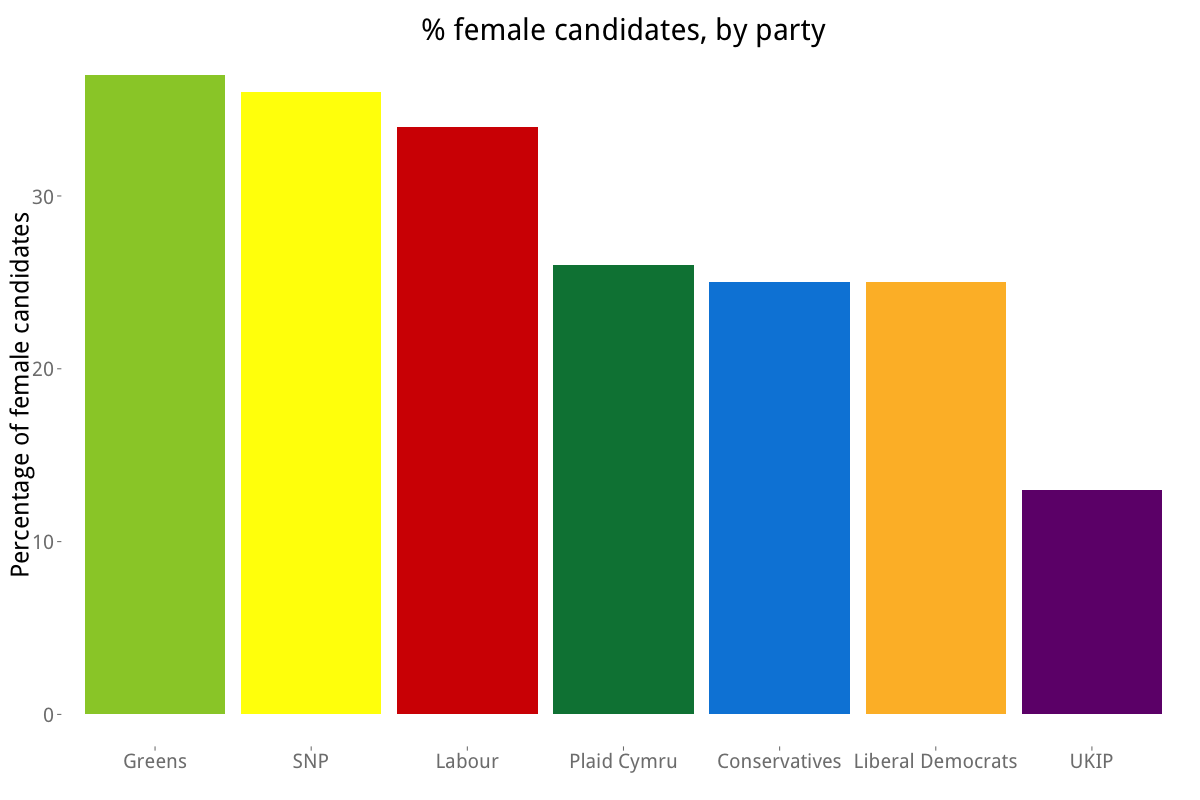The proportion of women elected to parliament in the UK remains low compared to other countries. In this post, Chris Terry examines the gender balance of parliamentary candidates for the upcoming election, and concludes that some progress is being made. Nevertheless, he suggests switching to a system of proportional representation would increase the descriptive representation of women faster than is likely under the current first-past-the-post system.
The importance of women’s representation in parliament should not be underestimated. That only 22.8% of our MPs are women is a shocking underrepresentation of half the British electorate. To function best, parliament needs the widest possible set of experiences from its representatives.
In the league table of women’s representation in parliaments, the UK languishes at a slightly embarrassing 56th out of 141 – below states such as Rwanda, Nicaragua, Algeria and Kyrgyzstan.
At the Electoral Reform Society our Women in Westminster report looked into how many women might be elected after the election, by modelling likely results. We found a likely rise after the next election to 29.5% women, which would put the UK up to a less embarrassing 36th. Yet progress remains slow.
For women to be elected to the Commons they must be selected by political parties. If a constituency is presented with no women candidates, then obviously it cannot possibly elect one. So the selection of women candidates by parties is of vital importance.

The Greens have selected the largest number of women candidates, though amongst the parties likely to win substantial numbers of seats, the SNP and Labour have the best record.
Yet, in order for there to actually be women MPs these women must be elected. In order to be elected they need to be in winnable positions. Women candidates deployed in seats certain to be won by male candidates from other parties will result in no further advance in women’s representation.
In target seats for the main two parties the story is positive, especially on the Labour side, with a majority of women selected in the party’s top 50 and top 100 targets.
However, when we look at safe seats the story is less positive.
Here the problem is incumbency. Once an MP is in a seat, they are difficult to deselect. And because our archaic voting system tends towards the creation of safe seats, there are a lot of places where incumbents stay in position for a long time.
Our report shows that of the 312 incumbents standing for election this year who were originally elected in 2005 or earlier, only 18.3% are women. Of the 67 incumbents elected before 1992 and standing again this year, just 11.9% are female.
These figures reflect a major reason for parliament’s continued male dominance. Women can only be elected in new gains or in seats where they replace retiring incumbents. However, there are only so many of these seats, and many continue to be held by men selected long ago. Hence large portions of parliament whose MPs were selected in less representative times for women remain essentially blocked until those MPs decide to retire.
This partly explains why Britain ranks so lowly. Countries with more proportional electoral systems tend to have superior gender representation.
Proportional systems also tend to avoid the situation amongst selectors where they can sometimes seek to select candidates who most look like their mental image of an MP – generally, male. In a multi-member constituency, parties tend to select a more diverse slate of candidates in order to appeal to the widest possible range of electors. Proportional representation also gives parties a larger range of options in terms of how they go about getting gender representation, with methods such as zipping or party internal gender quotas in selections.
Yet while Britain’s First Past the Post acts against the representation of women, the fact that the number of women candidates is going up and that the ERS are able to project a rise in women does show that parties can move forwards in this area. A change to a proportional system would make it easier for parties to improve gender representation, but that cannot be done in isolation.
Parties can and should work to guarantee better gender representation into the next parliament and beyond.
Note: This article gives the views of the author, and not the position of the General election blog, nor of the London School of Economics. Please read our comments policy before posting.
 Chris Terry is a Research Officer at the Electoral Reform Society
Chris Terry is a Research Officer at the Electoral Reform Society










Get PR first, then argue the nuances after. Otherwise the squabbles over details will prevent the objective from being obtained.
Mr Terry, the emphasise on encouraging more women to vote, but without emphasising the need for political reform has to be seen only as being as much being out-of-touch as politicians themselves.
Voting turnout will ONLY improve once the political system is reformed – RADICALLY reformed!
Remember, the public knows how it feels to be failed by political policy-making decisions. Additionally where are MPs targets – so that the public can fully acknowledge whether MPs are actually achieving goals for constituents? If MPs do not have a job title – and their achievements go unmeasured – why are we paying them £67,000.00 a year… with the potential of a raise to £100,000.00?
So much reform needed, but do you really believe that the neglect of increasing women Parliamentarians is the answer to our problems or RADICAL reform itself?